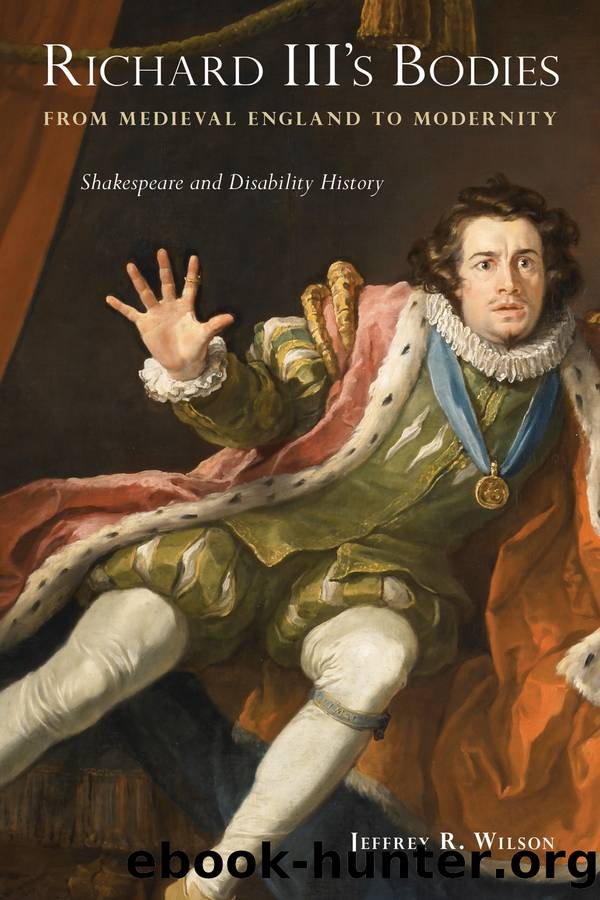Richard III's Bodies From Medieval England to Modernity by Jeffrey R. Wilson;

Author:Jeffrey R. Wilson;
Language: eng
Format: epub
ISBN: 9781439922682
Publisher: Temple University Press
Published: 2022-08-23T00:00:00+00:00
IV. Different Worlds: Dramatic Reality in Modernityâs Richard III
The late-eighteenth-century paradigm shift in readings of Richardâs disability occurred alongside a change in how the tent scene was understood, drawn, and staged. While Shakespeare allowed the visitation to be either ghosts or a dream, and Cibber encouraged the dream reading, the Johnson circle explicitly argued that it is a dream. Johnson reprinted Warburtonâs note that Richardâs conscience âtakes advantage of his sleep, and frights him in his dreams.â72 Montagu wrote a long chapter âOn the Praeternatural Beings,â looking especially at the Ghost in Hamlet, apologizing for Shakespeareâs superstitions by arguing that they are âallegorical beingsâ suited to âan age that affected abstruse learning.â73 Steevens gave a literary history of the Tudor chronicles that relates Richardâs disturbed dreams developing into Shakespeareâs âphantoms, speaking in their particular characters, on the stage.â74 And Griffith frankly stated that âthe Ghosts here are not to be taken literally; they are to be understood only as an allegorical representation of those images or ideas which naturally occur to the minds of men during their sleep.â75 Shakespeare set the scene at night, when Richard and Richmond are dreaming, she noted, âwhich intirely removes the seeming absurdity of such an exhibitionâ (320â321). Griffith elsewhere declared that Elizabethans misunderstood the mind: âadmonitions of conscience [were] taken for supernatural emotionsâ (77). Johnsonâs circle really was living in a different world than Shakespeareâs early-modern audiences.
Shakespeareâs audiences lived in the world depicted by Henry Fuseli, whose work always demonstrates a flair for the supernatural and, around 1769, shows the ghosts rising vertically through the trapdoor of the stage to haunt a sleeping Richard, candle burning in the center of the image to indicate the supernatural.76 This paradigm representing the tent scene as the âghost sceneâ includes another Fuseli drawing, lost to history, but preserved in James Neagleâs engraving, which shows some almost comically bedsheeted ghosts stacked vertically, one on top of the other, a candle burning on the left of the image.77 There is also a late-eighteenth-century sketch by a little-known artist known as the Master of the Mallet that shows an alert Richard visited by a King Henry VI who seems to be stepping down from heaven on stairs of clouds, past a burning candle.78 And there is William Blakeâs early-nineteenth-century watercolor painting of the translucent ghosts stretched out vertically around a fully awake Richard swinging his sword through their immaterial presence, a candle burning off to the left.79
But the paradigm soon shifted, perhaps symbolized by Fuseliâs 1777 sketch of Richard III Visited by Ghosts. The starkly black-and-white right side of the image shows a swirl of vertical movement, indicating the presence of the supernatural, while the lightly sketched left side shows Richardâs visitors in a horizontal train, one holding a mirror with lines drawn to Richardâs head, suggesting projections of his guilty conscience.80
By the late eighteenth century, Shakespeareans were altogether embarrassed by what Edward Capell called in 1779 âthat awful scene of the âGhostsâ rising.â81 Like Hogarth, the Danish Nicolai Abildgaardâs
Download
This site does not store any files on its server. We only index and link to content provided by other sites. Please contact the content providers to delete copyright contents if any and email us, we'll remove relevant links or contents immediately.
| Ancient & Classical | Arthurian Romance |
| Beat Generation | Feminist |
| Gothic & Romantic | LGBT |
| Medieval | Modern |
| Modernism | Postmodernism |
| Renaissance | Shakespeare |
| Surrealism | Victorian |
4 3 2 1: A Novel by Paul Auster(11074)
The handmaid's tale by Margaret Atwood(6874)
Giovanni's Room by James Baldwin(5896)
Big Magic: Creative Living Beyond Fear by Elizabeth Gilbert(4734)
Asking the Right Questions: A Guide to Critical Thinking by M. Neil Browne & Stuart M. Keeley(4599)
On Writing A Memoir of the Craft by Stephen King(4221)
Ego Is the Enemy by Ryan Holiday(4000)
Ken Follett - World without end by Ken Follett(3981)
The Body: A Guide for Occupants by Bill Bryson(3815)
Bluets by Maggie Nelson(3722)
Adulting by Kelly Williams Brown(3681)
Guilty Pleasures by Laurell K Hamilton(3600)
Eat That Frog! by Brian Tracy(3525)
White Noise - A Novel by Don DeLillo(3443)
The Poetry of Pablo Neruda by Pablo Neruda(3371)
Alive: The Story of the Andes Survivors by Piers Paul Read(3320)
The Bookshop by Penelope Fitzgerald(3237)
The Book of Joy by Dalai Lama(3234)
Fingerprints of the Gods by Graham Hancock(3222)
